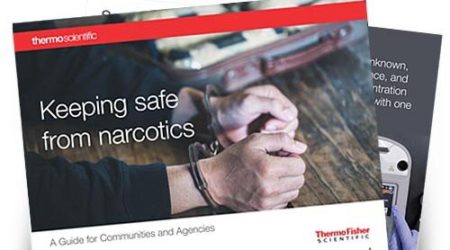 According to the World Customs Organization, in 2017, 1,256,256 kilograms of illicit narcotics were seized by customs officials in 105 countries. On a typical day, the U.S. Customs and Border Protection (CBP) seizes more than one ton of illicit drugs. In addition to dealing with more well-known drugs such as cocaine, heroin, and MDMA (ecstasy), Customs personnel now also have to face the rapidly growing challenge of synthetic drugs.
According to the World Customs Organization, in 2017, 1,256,256 kilograms of illicit narcotics were seized by customs officials in 105 countries. On a typical day, the U.S. Customs and Border Protection (CBP) seizes more than one ton of illicit drugs. In addition to dealing with more well-known drugs such as cocaine, heroin, and MDMA (ecstasy), Customs personnel now also have to face the rapidly growing challenge of synthetic drugs.
Synthetic cathinones — also called “bath salts” or “plant food”—and synthetic cannabinoids—often called “spice”—are broad categories of designer drugs that are pushing the capabilities of law enforcement worldwide, including those protecting customs and borders. With the emergence of extremely potent drugs like fentanyl and carfentanil, taking precautions to ensure officer and agent safety is more critical than ever.
The National Institute of Drug Abuse reports that “high doses of opioids, especially potent opioids such as fentanyl, can cause breathing to stop completely, which can lead to death. The high potency of fentanyl greatly increases risk of overdose, especially if a person who uses drugs is unaware that a powder or pill contains fentanyl. Fentanyl sold on the street can be mixed with heroin or cocaine, which markedly amplifies its potency and potential dangers.”
In the United States, the rise of fentanyl is of alarming concern. Customs and Border Security seizures of fentanyl have increased from only two pounds in FY13 to approximately 1,485 pounds in FY17. In 2019, it was proclaimed the deadliest drug in America.
In addition, new alternatives appear on the market faster than countries can make a certain drug type or derivative illegal thereby circumventing the new laws. With drug targets evolving so rapidly, those agencies chartered to police such activities must keep pace by deploying the latest testing methods. In some locations, if Customs officials suspect a package may contain drugs, it can be sent to a lab for analysis, which could take hours—even days. The result is that commerce is slowed and legal shipments can be delayed. Field-deployed technology helps to eliminate this problem.
On a typical day, according to the CBP, more than 67,000 cargo containers are screened, yet virtually all of the illicit opioids, including synthetics such as fentanyl and its analogues, enter the country through our international land, air, and sea borders, including through international mail facilities. This includes 475 million international mail and express consignment parcels entering the United States in FY17, or 1.4 million daily.
The illegal drug trade is a worldwide issue. We recently wrote how the China Seas Coast Guard intensified efforts to eradicate illicit drug trafficking and was putting a dent in this traffic with active interdiction and on-the-spot, real-time detection when vessels are intercepted, stopped, and searched either in coastal waters or on the high seas. Our article about the Taiwan Coast Guard identifying $30 million in drugs discussed how the Taiwan Investigation Bureau warned of a sharp rise in the consumption of illegal drugs, urging relevant agencies to tackle the problem and proposing law enforcement cooperation with other countries to combat increased cross-border drug trafficking. The report explained that given Taiwan’s location and its strong distant-sea fishing industry, the island has been increasingly used by international drug rings as a transshipment hub for drug trafficking.
Protecting borders is especially difficult, but it is crucial to detect and deter dangerous substances before they reach the public. Customs and Border Protection (CBP) organizations charged with stopping narcotics, new synthetic drugs, and other illicit substances from crossing borders need narcotics identification tools that provide immediate analysis at the port of entry. There are handheld Raman/FTIR instruments that provide highly accurate results directly at the scene, enabling officers, customs agents, border control, and other personnel to scan substances in a single, definitive test.
For rapid identification of suspected narcotics in the field, among the ships, at the airports, at the borders, there are handheld narcotics analyzers that utilize the well-established analytical technique called Raman spectroscopy. These tools can scan through transparent/translucent containers, plastics bags, and bottles for most samples.
This instrument easily identifies narcotics, stimulants, depressants, hallucinogens and analgesics. It can analyze key drugs of abuse as well as common cutting agents, precursors, and the emerging threats of fentanyl, cathinones and bulk cannabinoids that we noted earlier — ensuring that Customs officials are always ahead of the curve.
With a mission to safeguard the public by safeguarding the products and raw materials that enter through ports of entry and borders, Customs and Border Protection personnel can achieve success through international collaboration, targeted operations, and the deployment of innovative technology.
Suggested additional reading: Customs and border protection on the front line




Leave a Reply